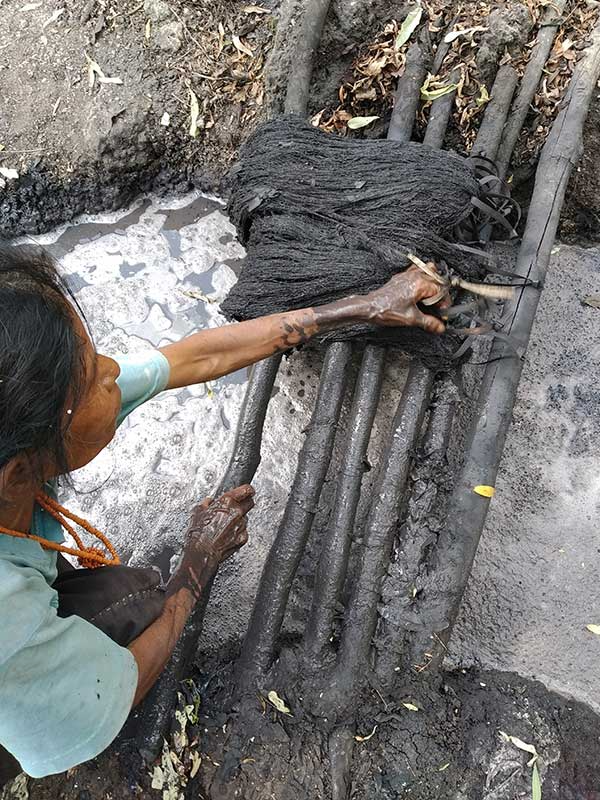Mud Dyeing in Sumba: Peer to Peer Learning

Mud dyed threads in proces
During this trip to East Sumba we had the fascinating opportunity to observe the traditional mud dyeing process.
We joined our friends Umbu Kanabu Ndaung and Tamu Hamu Rambu Eti from Rindi to meet with a master mud dyer (pakapihak) who gathers her tannin materials from the forest.

Walking up to the forest to work with the master mud dyer

Young leaves from Syzygium acuminatissimum are used for tannin
While it is wonderful that this traditional technique is being continued, the harvesting techniques are having a heavy impact on the small remaining forest of this species.
Threads of Life has always worked with traditional communities on a peer-to-peer basis. So we asked if we could also dye alongside the dyer to achieve the same black mud dye but using our recipe. By comparing and contrasting the results, we could then talk about sustainable practices.

Threads of Life does not impose our ideas but we share our learnings on a peer to peer basis

Younger generation of dyers participating in the process will decide which process to continue
We also brought two young weaverq and dyers along from Rindi Village, who we hoped might be willing to adopt our technique that used Woodfordia fruticosa, a fast growing tannin source that is found everywhere on the scrub lands of Sumba rather than the endangered tannin sources from the forests.
I was fascinated with the dyers technique and admired the knowledge and skill she used to achieve her mud dyed black colour. She collects mud from buffalo pens and dries it, and then reconstitutes the mud mixing it with wood ash. She has two pits in the ground, one for her mud, and one for her tannin after it has been boiled. She works in the hills near a river which allows her easy access for washing the finished threads. The young leaves of what is called Ai Lobung locally (Syzygium acuminatissimum) along with the stems and leaves of Woodfordia fruticosa are dried and then simmered in an old oil drum for a day. Syzygium acuminatissimum was first identified (by science) as a tannin source for mud dyeing in the late 1800s.

Processing mud dyed threads in the traditional way

Dried leaves that contain a high content of tannin are boiled and threads are then soaked in this solution
Threads are boiled in this mixture and then taken out to be worked in the mud. This process is repeated until a deep black colour is achieved. I took white threads and then I used only the Woodfordia fruticosa (which grows abundantly) and then worked my threads in the same mud and achieved a good black colour after five repetitions. We talked about how it is not necessary to use the young leaves of Ai Lobung as there is just as much tannin in the fallen leaves. This means that the forest does not have to be disturbed.
It is unlikely that the elder dyers will change their techniques but it is my hope that the young dyers may be willing to use a more sustainable and simple technique for their ongoing work. We will see when we return next year.

We hope the younger generation will consider using a technique that keeps their forests safe

